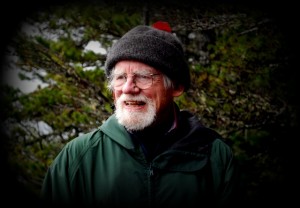1931 – 2012

To have called John S. Edwards a Renaissance Man would be an understatement. He was a great naturalist and adventurer: he was especially fond of exploring “the secrets of strange insects that live in cold places.”
John was known around the world as one of the pioneers of insect developmental neurobiology. He was also a leading scholar in the ecology of high-altitude insects, cold tolerance of Antarctic insects, the role of insects in ecosystem regeneration following volcanic eruptions, and the evolution of insect flight. His academic passions extended far beyond science. He was also deeply knowledgeable about early American landscape painting and about early European music. This diversity of interests was apparent in his youth: his undergraduate adviser told him that he suffered “from responding to an excessive diversity of stimuli.”
John was a skilled mountaineer. He climbed around the world, made first ascents in Alaska, was on the expedition that made the first winter ascent of Denali, and was elected to the Alaska Sportsman Hall of Fame. He put his mountaineering skills to academic use in his pioneering studies of the ecology of high-altitude insects. His love of mountains inspired him to devote considerable efforts to protecting the North Cascades, including serving ten years on the board of the North Cascades Conservation Council.
Born in New Zealand in 1931, John received his Bachelor’s and Master’s degrees from the University of Auckland in 1954 and 1956, respectively. He earned his doctorate degree in 1960 with Sir Vincent Wigglesworth at the University of Cambridge. He then became an Assistant (and later Associate) Professor at Case Western Reserve University in Ohio. In 1966 he interviewed for a position in the Department of Zoology at the University of Washington, and he received the Department’s offer letter via an airdrop at Base Camp on Denali. John’s climbing adventure apparently annoyed the Chair of Zoology, who was relieved when John returned alive (one of his fellow climbers had perished).
At the UW John taught entomology, human ecology, and other courses for decades. He served as the Director of the Undergraduate Biology Program from 1982-87 and Director of the UW Honors Program from 1994-2000. He was appointed Emeritus Professor of Zoology in 2000, but his support for students did not end with this retirement. In 2009, John generously established the John S. Edwards Endowed Fund in Biology to provide support for graduate students conducting research in environmental biology.
John received many prestigious awards throughout his career, including a Guggenheim Fellowship, a Senior Humboldt Research Award, and a Jacob Javits Neuroscience Investigator Award from the NIH. He was a University Liberal Arts Professor and was named a Fellow of the American Association for the Advancement of Science and of the Royal Entomological Society of London. He served as Program Director for Developmental Neuroscience at the National Science Foundation.
John was passionate about early music. He learned to play the harpsichord in his 70s, and was an active supporter of the Early Music Guild in Seattle.
John’s personality is well described in this passage from Art Davidson’s account of the first winter ascent of Denali (Minus 148°):
“Though none of us had met John, people at the Institute of Arctic Biology, where I worked and where he had once held a position, spoke of him as an extremely delightful overgrown elf. He was fabled to be amiable, boisterous, occasionally mischievous, and at the same time a thoroughly levelheaded and thoughtful fellow. My first meeting with John reaffirmed the legend. I had traced the sounds of a concert through several corridors at the Institute to a short figure hopping about from leg to leg while vocalizing the entire woodwind section of an orchestra. This apparition’s large, elfin ears stuck out from generous locks of golden hair, his hands rapidly punctuated the air in time to the symphony, and his light-blue eyes flashed me a quizzical glance. It was John.”
Bruce Barcott described an encounter with John in his UW laboratory in Measure of a Mountain, in the chapter titled “Aerial Plankton”. Elsewhere in the book, Barcott also talks about meeting Oma Edwards, John’s wife, and mentions her work to determine the true age of alpine heather plants.
John Edwards is survived and remembered fondly by his four loving sons, Richard, Duncan, Marten, and Zachary, and their families. John will be missed for his friendship, his wit, and his wisdom – and for his unbounded love of insects, music, and high places.
